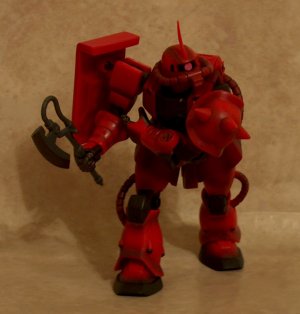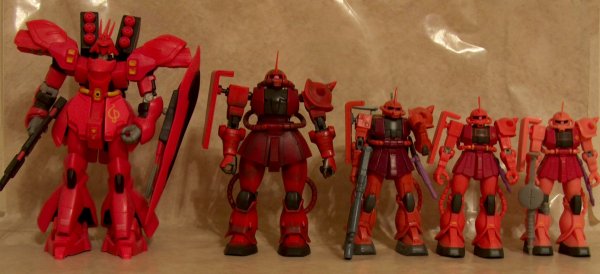Gundam the Origin MS-06 Zaku


|
The demise of the Gundam, Mobile Suit in Action line here in the US has left a hole in my toy buying. I've watched as
countless new figures came out in Japan. So when I went to Wizard World Chicago this year I was hoping to pick up some
of the import figures. Sadly that didn't work out as MSIA figures were all but completely absent. But I did pick up
on addition to my mecha army, the Gundam: the Origin MS-06 Zaku. Gundam: the Origin is a manga (comic) version of the
original Mobile Suit Gundam anime series.
Packaging - 5/10The packaging for the Origins figures is an interesting design. The figure and accessories are displayed in a clear plastic tray in front of a half dozen images from the comic. That tray is then inside of a box with a large opening in the front. But instead of a piece of plastic glued to the inside of that window, there is a large piece of plastic that covers the entire front and side panels of the box. The back of the box has several photos of the figure in various poses and with the different accessories. The top section has a few images from the manga as well. The packaging is simple and fulfills its purpose. But it has a couple of drawbacks. First of all, from my description of the packaging design you would probably think that the figure was well protected. But it isn't, or at least no more so than if it were on a more standard card. The materials used for each layer of packaging is quite thin, including the box itself. And only the inner tray has enough structure to hold its shape on its own. As an opener, I don't mind that too much. What I did find odd was that for all of the images from the manga used on the packaging, there is not a single image of an entire Zaku. I really expected at least one image to compare the toy to the source material.
Sculpting - 4/10For Bandai to have produced another version of the Zaku II, I was anticipating some significant changes from the previous figures, particularly since the version 2 Zaku wasn't released all that long ago. But that is not the case. The most notable change is a simple difference in scale. The Origins version of the Zaku II is considerably larger than most of the past MSIA figures. The increase in size is not accompanied by an increase in detail though. If fact, there is even less detail on the Origins figure than the version 2 Zaku II. It's the joints that really hurt the score though. The elbows and knees in particular can look very strange due to the unique design of those joints. But the lack of concern for the aesthetics is clearly visible elsewhere, like the shoulders as well. The left shoulder is hidden by the spiked cover. But the right shoulder which has the shield attached is left completely open on the sides and top. While such sacrifices do help give the figure an impressive range of motion, the negative effects on the sculpt can't be overlooked.
Paint - 8/10The paint work is the one area in which the Origins Zaku II shows clear improvement over the past offerings. To begin with, it has the best shade of red of the four versions of Char's Zaku II that I have. This is no bubble gum pink like the first version. Bandai also did a nice job using a paint wash to add shading. The only thing the figure is really missing is the decals of the domestic figures. I've yet to figure out why they are left off the Japanese figures.
Articulation - 10/10The Origins Zaku II sports an impressive 38 points of articulation:
Accessories - 5/10The Origins Zaku II comes with a rifle, heat hawk, two extra hands and two cables to attach to the backpack. Rifle is nice. It appears to be a beam rifle instead of the traditional rifles with circular ammo canisters that the they carried in the anime. The rifle has one of the extra hands permanently attached to it which is rather strange. So if you want to equip the rifle, the existing hand has to be removed first. The rifle has an optional handle on the front under the barrel so that it can be held with both hands and the sight can be moved as well. Once attached, the rifle can be connected to the backpack via the included power cable. When the rifle is not equipped, the cable can be removed and replaced with a short version to appear as if the cable has been retracted. The heat hawk can be held in either or the grasping hands, or stored on the right hip. The hands include the two grasping hands that come on the figure, the hand that is attached to the rifle, and a fourth open hand which can be connected to the right arm. The accessories included cover all the basics but nothing more.
Value - 4/10The original retail price for the Origins version of the Zaku II was just under 3000 yen, or about $26. I picked mine up for $20 at Wizard World Chicago. Even at that price, you are not getting anything particularly special for your money. The 2nd version MSIA figure, while slightly smaller in size, offers a figure that is equal to if not better than the Origins version, with more weapons and at half the price.
Happy Hunting:As I said, I bought my figure at Wizard World Chicago from the booth for House of Anime. It is also available from thier website at www.hoa.com. But the price is a bit steep at $35. You can find it for less on Ebay. But if the seller isn't in the US, it could still end up costing a hefty sum.
|

|








